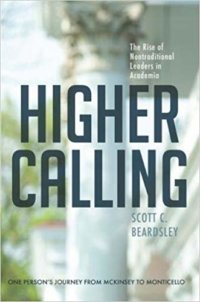Higher Calling: The Rise of Nontraditional Leaders in Academia

Higher Calling: The Rise of Nontraditional Leaders in Academia. Scott C. Beardsley. Charlottesville: University of Virginia Press, 2017.
According to Beardsley, a revolution is taking place among the leadership in American higher education: presidents, deans, and other administrators are coming from nontraditional paths than from the scholarly, tenure-track careers of the past. In 2012, 20% of all presidents came directly from a position outside of academia with the trend only increasingly in the future. What does this mean for American higher education, especially for liberal arts institutions, is what Beardsley sets out to examine in his book.
The context of liberal arts college has changed radically from one of no competition to intense competition where even large, research institutions offer special undergraduate environments mirrored after liberal arts college. Ranking and outcome measurements have pushed liberal arts college to address their own institution’s economics to ensure their viability. Liberal arts college have to spend more on scholarships to retain the same quality of their incoming class, raise tuition, and accept more students to balance their budgets.
Given this context, presidents of liberal arts college need to raise the institutional profile and visibility of their college, increase its financial capacity, and articulate a long-range plane that is distinctive to the institution. These presidents need to be innovative, creative, effective fundraiser, able to forge relationships with various community, have management, marketing, and business acumen while, at the same time, maintain academic excellence and rigor for students. In short, it is critical for presidents of liberal arts college not to locus focus of the school’s mission.
However, there is a thinning pipeline of people preparing to be president with greater turnover, shorter tenures as well as the rise of a headhunter culture where presidents are offered larger salaries elsewhere. This creates a window of opportunity for nontraditional leaders at liberal arts college. What these nontraditional leaders offer is transformational leadership and change management skills in collaborating with disparate groups and involving them in the development of a strategic plan of how to make an organization better. Critical is their fund-raising ability, which requires a high level of energy, to implement their vision.
The data indicates that only 14% presidents in the West are from nontraditional backgrounds, while 41% in the South, 37% in the North, and 31% in the Midwest. Lower ranked liberal arts college with smaller endowments and lower graduation rates were more likely to have a nontraditional president while higher ranked liberal arts colleges with large endowments and higher graduation rates have traditional ones. Religiously affiliated liberal arts college were also more likely to have a nontraditional president (40%) compared to non-religiously affiliated ones (27%).
Individuals who seek to be a president of a liberal arts college should familiarize themselves with academic culture, particularly the norm of shared governance, narrow the credential gap (i.e., obtain a terminal degree), understand the recruiting and selection process, seek mentors, work existing networks, display respect for traditional academic traditions and priorities, and be an advocate for the institution and its community. Once president, it is imperative to build the right team, earn legitimacy, thwart faculty’s confirmation bias, immense yourself in the culture, and learn best practices and leadership both at the home institution and elsewhere. To see whether it is the right fit between a nontraditional president and an institution, Beardsley suggest to five “lenses” to assess the situation: mission and values, problems to be solved, leadership authenticity, chemistry, and family compatibility. Both parties need to be on the same page on these five points if the institution is to succeed.
In his epilogue, Beardsley recalls his own experience becoming dean at the University of Virginia. During the transition and first year, he recounts what he had learned from his predecessor and how he met with various stakeholders. It finishes the story that he started in the prologue where he goes to great lengths of his experience at McKinsey and how it helped him for his current academic position.
While Higher Calling identifies a serious and significant problem in higher education, it does not make the complete case why nontraditional leaders would be as good, if not better, than traditional leaders in higher education and particularly in liberal arts colleges. Although it makes the case for nontraditional leaders in higher education, it does not isolate what specifically they bring to academia that traditional leaders lack. Surely traditional leaders also have transformational leadership and change management skills that nontraditional leaders claim to possess, so is the difference one of perspective, working culture, or something else? In many ways, Higher Calling opens the conversation about the need for new and different leadership in American higher education but falls short of explaining what that would look like when compared to the old.




